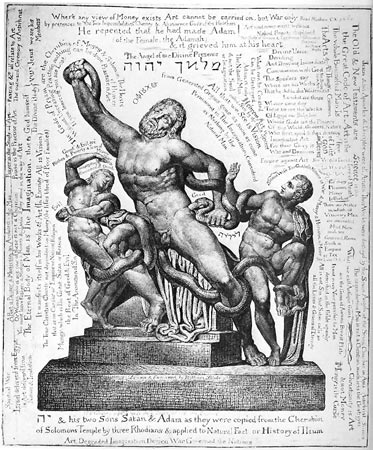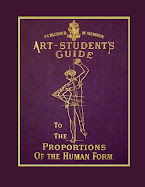Alessandro Allori (1535-1607), Laocoon, c. late 1550s, Oil on panel, 73 x 57.2 cm, Private Collection, New York. From The Dramatic Work of Artists Who Had a Pope as Their Patron

Johann Georg Heck,Iconographic Encyclopaedia of Science, Literature, and Art, Tafeln 6.
Top Row Left to Right: 5. Hercules with the boy Telephus on his arm, in Rome, 1. Statue of Antinous of Belvedere, 6. Boy wrestling with a goose, 8. Statue of Meleager, in Rome, 4. Statue of Germanicus, from the 15th century; it belongs to the period of the revival of art, but the sculptor is not known.Bottom Row Left to Right: 2. The Apollo of Belvedere, 7. Laocoon, in the Vatican, 3. Statue of a Faun.

The Art Student's Guide to External Anatomy
Encyclopédie, ou, Dictionnaire universel raisonné des connoissances humaines By Denis Diderot, Fortuné Barthélemy de Félice. Laocoon from the Encyclopedia.

Laocoon from Audran's book.

Hagesandros, Polydoros, and Athanadoros of Rhodes. Laocoön and His Sons perhaps the original of the 2nd or 1st century BCE or a Roman copy of the 1st century CE. Musei Vaticani, Museo Pio Clementino, Cortile Ottagono, Rome.

Marco Dente, Laocoonte, stampa, bulino, ante 1523 from 1523: il Laocoonte vaticano al Belvedere prima delle integrazioni Engramma Galleria.

Laocoon by William Blake with text from mlahanas.de
From A history of ancient sculpture, Volume 2 By Lucy Myers Wright Mitchell
The Laocoon group, now in the Vatican, was discovered in Rome in 1506, near the Sette Sale, the site of Titus' palace on the Esquiline. Popular tradition indeed continues, through the modern guides, to point out, as the spot of its discovery, the Baths of Titus, where the niche is shown from which it is said to have been taken, — proved, however, by measurements, to be much too small for the large pedestal of the Laocoon group. The site of discovery corresponds, then, with Pliny's statement; but in one feature the Vatican Laocoon fails to coincide with what the Roman writer says, viz., as to its being of one block. Michel Angelo, who attempted but relinquished the restoration of the right arm, found the group to be composed of three different pieces ; and subsequently three other blocks were distinguished. Repetitions of certain parts of the group exist, but are either late Roman copies, or, in some cases, directly traceable to the sixteenth century, when the Vatican group was greatly admired, and parts of it copied.1184 There can, therefore, be little doubt, that the Vatican Laocoon is the identical work mentioned by Pliny, as being in Titus' palace; and that his statement, that it was in a single block, is due to his love of the superlative, is confirmed by the fact that he makes the same assertion with regard to the Farnese Bull.

From Painters, sculptors, architects, engravers, and their works: A handbook By Clara Erskine Clement Waters
Agesander, native of the island of Rhodes. Pliny is the only writer who speaks of him, and but one work of his is known,— the " Laocoon " of the Vatican. In this he was assisted by Polydorus and Athenodorus. Another statue, found at Antium, shows that Athenodorus was the son of Agesander. It is thought not unlikely that Polydorus was also his son, and that the figure of Laocoon was executed by the father, and the remaining figures by the sons. This group was found near the baths of Titus, on the Esquilino Hill, in 1506. It is considered a most perfect work by all competent judges, and is very wonderful from the fact, that while it portrays the most intense suffering in every feature, limb, and muscle, it still has the sublime repose of true Grecian art. Laocoou was a priest of Apollo, and had committed some crime against that god, who sent two immense serpents from the island Tenedos to kill him just as he was ottering a sacrifice, assisted by his two sons. Laocoon had opposed the reception into Troy of the horse left by the Greeks; and his death was believed by the Trojans to be a divine punishment for this; therefore a breach was made in the walls and the horse admitted; thus the death of the priest decided the ruin of Troy.

IL LAOCOONTE GIA AMMIRATO NEL PALAZZO DI TITO E SCOLPITO DA AGESANDRO POLIDORO from Domenico de Rossi’s - Raccolta de Statue Antiche e Moderne.

The analysis of beauty By William Hogarth
OF SIMPLICITY, OR DISTINCTNESS
Simplicity, without variety, is wholly insipid, and at best does only not displease; but when variety is joined to it, then it pleases, because it enhances the pleasure of variety, by giving the eye the power of enjoying it with ease.
There is no object composed of straight lines, that has so much variety, with so few parts, as the pyramid: and it is its constantly varying from its base gradually upwards in every situation of the eye, without giving the idea of sameness, as the eye moves round it, that has made it been esteemed in all ages in preference to the cone, which in all views appears nearly the same, being varied only by light and shade.
Steeples, monuments, and most compositions in painting and sculpture, are kept within the form of the cone or pyramid, as the most eligible boundary, on account of their simplicity and variety. For the same reason, equestrian statues please more than the single figures.
The authors—for there were three concerned in the work—of as fine a group of figures in sculpture, as ever was made, either by ancients or moderns, I mean Laocoon and his two sons, chose to be guilty of the absurdity of making the sons of half the father's size, though they have every other mark of being designed for men, rather than not bring their composition within the boundary of a pyramid, figure 2, plate 7. Thus if a judicious workman were employed to make a case of wood, for preserving it from the injuries of the weather, or for the convenience of carriage, he would soon find by his eye, the whole composition would readily fit and be easily packed up, in one of a pyramidal form.


My Laocoon: Alternative Claims in the Interpretation of Artworks (California Studies in the History of Art Discovery Series)
The Analysis of Beauty

 The Works of William Hogarth: (Including the 'analysis of Beauty, ') Elucidated by Descriptions, Critical, Moral, and Historical; (Founded On the Most ... Which Is Prefixed Some Account of His Life
The Works of William Hogarth: (Including the 'analysis of Beauty, ') Elucidated by Descriptions, Critical, Moral, and Historical; (Founded On the Most ... Which Is Prefixed Some Account of His Life
The Analysis of Beauty




















No comments:
Post a Comment